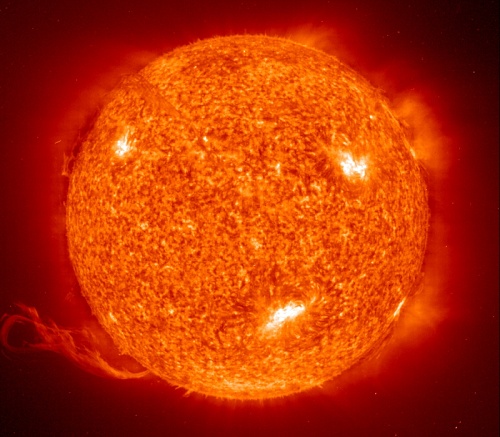Gyrochronology, a new method for accurately determining the ages of field stars based on their rotational rates, is being announced today by Sydney Barnes, Lowell Observatory astronomer. This fundamental research, “Ages for illustrative field stars using gyrochronology: viability, limitations and errors,” is accepted for publication in an upcoming issue of the Astrophysical Journal.
The age of a star is its most fundamental attribute apart from its mass. A star’s age tells astronomers how astrophysical phenomena change over time. “For example, the ages of the host stars of planetary systems are needed to understand how these systems change over time,” says Barnes.
By showing that the rotation period of a star is a steadily changing and tight function of its age and color, gyrochronology allows the age to be determined by measuring the two other properties — the rotation period and the color. “If you know the relationship between three quantities, measuring two of them allows you to calculate the third,” says Barnes. “The relationship between age, color, and rotation period has particular and useful mathematical properties that simplify the analysis and allow the uncertainties to be calculated easily.” A star’s color is a proxy for its mass or surface temperature. The uncertainties in gyrochronology ages are typically 15 percent; with preexisting stellar aging methods the uncertainties range from 50 to 100 percent.
Gyrochronology can be calibrated using the known age of the Sun (4.6 billion years). Another distinguishing characteristic of the technique is that it works well for the vast majority of stars including field stars, or those not found in star clusters. For the first time, this new technique makes possible the derivation of accurate ages for solar- and late-type main sequence stars using only their rotation periods and colors. In his new paper, Barnes calculates ages for sun-like and other low mass stars that burn their hydrogen fuel at a relatively steady rate on what is known as the main sequence. Barnes derives ages for sample stars where rotation and color are known, but the stellar ages using other methods are not known.
The technique builds on an insight of Skumanich in 1972 who noticed that another measure of stellar rotation changes steadily with the ages of star clusters. However, the related imprecision greatly compromises the accuracy of ages derived using this insight alone. Measurements made at Lowell Observatory in the late 1980s showed that rotation also depends on the color/mass of a star. Gyrochronology combines and develops these two insights into a precise way of deriving stellar ages, and shows that it works even for single field stars. The paper shows that the rotation period of a star (whether in a cluster or in the field) can be written as a simple product of two separable functions of its age and color. This mathematical behavior provides the key simplification that makes gyrochronology unique.
Preexisting methods for attempting to determine stellar ages are the isochrone and chromospheric techniques. The isochrone method was first named by Demarque and Larson in an elegant 1964 refinement on pioneering work by Allan Sandage. Isochrone ages are derived through computations of the evolutionary tracks of stars. Barnes’ study points out that, while the isochrone method works well for star clusters, it does not work well for individual (field) stars because it requires the distance to measured. And that is difficult. The study shows that another reason isochrone ages are not satisfactory is that they do not work well for stars on the main sequence, where the majority of a star’s life is spent. “However, gyrochronology is independent of distance and works well on main sequence stars,” said Barnes.
Another method for determining ages of stars is the chromospheric method, a breakthrough developed by Olin Wilson and others since the 1960s. Chromospheric ages are calculated using the measured chromospheric emission from stars. These ages are not dependent on distance and can be used on main sequence stars. However, chromospheric ages have large uncertainties of up to 50 percent. The uncertainties in gyrochronology ages are typically 15 percent.
In additional analysis, Barnes used gyrochronology to demonstrate that, unlike results using other techniques, the individual components of three wide binary stars have essentially the same ages.
Gyrochronology does not work well for the youngest stars, those that have not begun burning fuel at the steady rate indicative of the majority of stars (main-sequence) stars, or for those that have left the main sequence. However, future work might be able to extend the method for these stars as well.
For the vast majority of stars, gryrochronology ages are shown to be more consistent than other stellar aging techniques and will have applications across the field of astronomy. For example, NASA’s Kepler Mission, being readied for launch, is likely to yield not only discovery of new planets through observations of the transits of these new planets moving in orbits across the disks of their host stars, but also the rotation periods of those host stars. Kepler is likely to yield rotation periods for orders of magnitude more stars than planetary transits. “No matter what, stellar rotation periods will be determined routinely as time domain astronomy comes into its own,” said Barnes. “A very significant portion of time domain work on stars will yield the stellar rotation period (it is a by-product of all searches for planetary transits), and since this measurement can be used to derive a precise stellar age, it would permit us to address many problems involving chronometry that are not presently solvable.”
“The age of a star is its most fundamental attribute apart from its mass, and usually provides the chronometer that permits the study of the time evolution of astronomical phenomena,” said Barnes. “Gyrochronology refines the use of stars as clocks, revealing their own ages, and the ages of associated astronomical bodies.”










